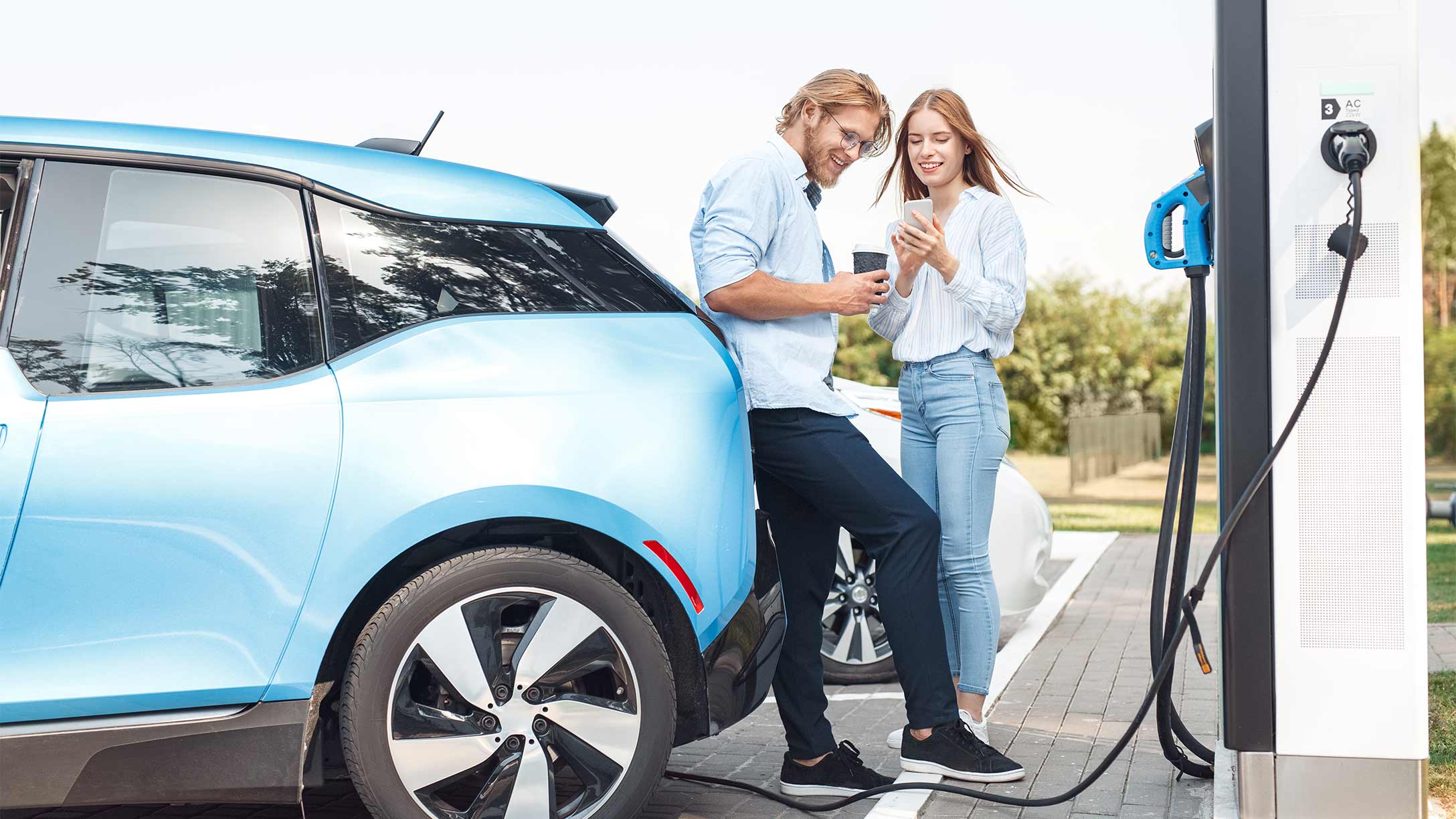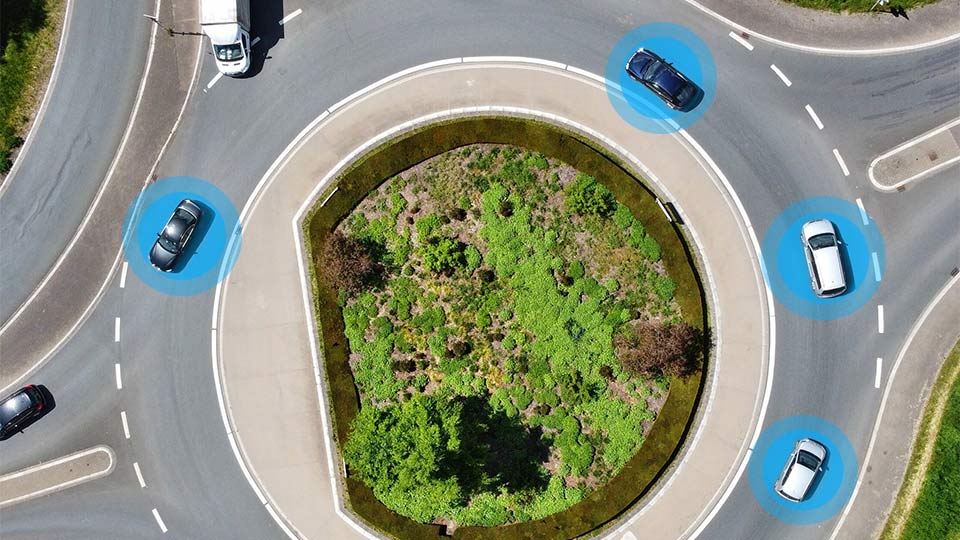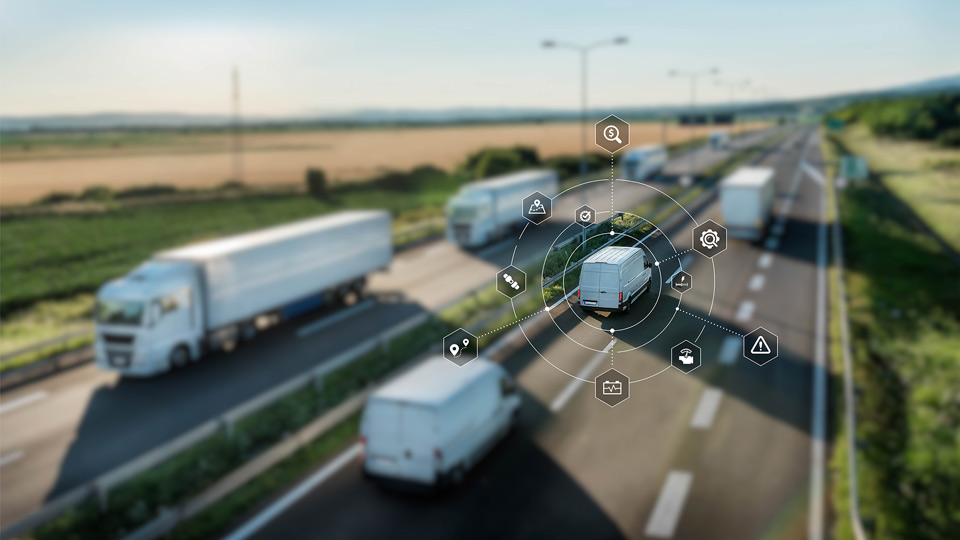
The EV Drivers Handbook

Table of contents
Foreword
The road to vehicle electrification is well underway with close to 800,000 electric vehicles (EVs) on the UK roads today. Furthermore, the Irish government has a target to reach over 900,000 EVs by 2030 which is equivalent to one-third of the vehicle fleet. The first two quarters of 2021 saw significant growth in the battery-electric vehicle market compared to 2020, in both the passenger and light- commercial vehicle market. The UK and Irish governments push to ban the sale of new internal combustion engine (ICE) passenger vehicles and vans by 2030, and heavy-duty vehicles by 20401 means that any vehicle driver today will at some point in the near future have to consider an electric alternative.
Taking the steps to transition to an EV is an obstacle that businesses face in an evolving marketplace. Geotab has over a decade of experience with EV telematics, and with that knowledgeable insights into shaping the answers to the difficult questions that fleets face when building an electrification strategy. Moreover, early adopters are helping us understand some of the key challenges faced in the pathway to electrification. This handbook attempts to overcome those challenges not only as drivers transition to EV, but also methods and best practices in utilising the EVs the right way on an ongoing basis.
Chapter 1: When is the right time for an electric vehicle?
One size certainly doesn’t fit every scenario. The questions that are asked regarding when the right time for an EV revolve around making the electrification process simple, economical and as seamless as possible. Driven by a multitude of factors, including the banning of ICE vehicles, and ambitious vehicle manufacturer targets, EVs are also becoming more affordable. So when is the right time to electrify? That answer depends on you, the goals of your business and where you see yourself in the future.
Tip 1: Focus on the total cost of ownership
The total cost of ownership (TCO) is where EVs stake an economic claim. Leaseplan’s Cost Car Index2
analyses the competitiveness of EVs in relation to ICE counterparts, and in 2021, in a number of segments, EVs have a more competitive TCO over the first four-years of ownership, assuming 30,000 kilometres driven annually.
Furthermore, businesses are acquiring EVs for trial purposes. This way fleets can begin to understand the dynamics of EVs and identify which portion of the fleet to switch first. High vehicle utilisation can offset the extra upfront costs with fuel and maintenance savings3.
The best place to start whether you are an individual or fleet driver is understanding the typical duty cycle of the vehicle and how many miles the vehicle drives on a daily basis. The general rule of thumb to establish a strong
total cost of ownership is to identify the vehicles that are utilised just enough not to reach range limitations of EVs, but enough to benefit from the reduced fuel and maintenance costs.
Telematics helps to understand the driving characteristics of your ICE vehicles, making it the perfect starting point to understand current operating costs.
EVs help drive sustainability efforts forward but keep in mind, there are also many cost savings aspects that come along with it. Focus on all the costs associated with vehicle ownership and not just the sticker price.
Typical factors to consider when comparing ICE and EV ownership costs:
- Purchase price
- Plug-in incentives
- Depreciation/residual value
- Fuel
- Service, maintenance, and repair
- Insurance
- Finance costs for leasing
- National Insurance Contributions (NIC) / Benefit in Kind (BiK)
- Clean Air Zone Fees
- Vehicle Excise Duty (VED)
Tip 2: Don’t overlook incentives
The UK has an array of benefits in place that incentivise the uptake of EVs, but also, discourage the ongoing operation of ICE vehicles. The most common include purchase grants, which essentially reduce the upfront cost of an EV, and have been extended to the purchase and installation of EV charge points.
Take the overall factors such as TCO calculations and government incentives into consideration before making the switch to EV.
The growing trend of EV salary sacrifice
For company car drivers, the emergence of EV salary sacrifice schemes is encouraging the rates of adoption4
. They work in the same way that Cycle to Work Schemes do, and are now available from a number of companies in the UK5.
The scheme allows an employee to pay for an EV using their gross salary, with tax calculated based on the BiK rate which for BEVs is 1% in 2021-22, then only 2% in 2022-23 and 2023-246. BiK is the value of the benefit you receive, which is resulting in significant savings compared to a personal lease, and in some cases will include insurance and maintenance of the vehicle.
For example, purchasing a Vauxhall Vivaro-e with a 50 kWh battery price starts at just under £50,0007, and is eligible for up to £6,000 off the sticker price.
Chapter 2: The charging dilemma
One of the key challenges when acquiring an EV is understanding where to charge the vehicle. Unlike ICE vehicles where petrol stations are in abundance and easily accessible, drivers at times may feel range anxiety about EVs. While EV charging requires a shift in behaviour, the disruption can be minimised and managed. In fact, charging an EV can be more convenient than fueling an ICE vehicle if it can be plugged in at its primary dwelling - which could be at the driver’s home, the depot or the workplace.
There are a number of charging solutions, but the options are constantly evolving.
For mass adoption of electrification for UK businesses and the public, a multitude of options will be required. Not everyone is in the same scenario. In Edinburgh, 36%1 of the population have no off-street parking, whereas in London, this is as high as 60%. Therefore, these residents will rely on the public infrastructure or community charging solutions.
Earlier adopters of EVs across the fleet sector, have predominantly been those who wanted to drive forward sustainability efforts, realised the savings from a total cost perspective and had easier access to charging infrastructure.
However, the use cases are expanding. Employees with off-street parking provides the perfect opportunity to charge the vehicle at home, and one third of UK businesses are now considering the installation of home charge points for drivers2 . This benefits the company in two ways: it helps reduce the capital cost of infrastructure, but also is the lower cost option for companies. This is because charging at home is the most economical, and can be coupled with cheaper off-peak overnight charging tariffs.
Note: is home charging an option? This is often the cheapest way.
In parallel with the consumer market, it will take time for fleets to build confidence in utilising public infrastructure. Similarly for longer haul journeys, on-route charging will be a necessity. Some of these barriers are beginning to break down, with a growing number of public charge points. Ofgem3 , the energy regulator has pledged a £300 million investment to upgrade the infrastructure connections which will allow for more rapid chargers made available to the public.
To build confidence in this network, consumers and businesses alike need visibility on charger availability, power level, routing, cost and payment options.
Tips for charging infrastructure planning:
Vehicle data can help to understand:
- Vehicle miles driven
- Where vehicles are stationary
- EV driving energy, and charging infrastructure power needs
Chapter 3: The EV expectations
One of the greatest concerns while driving an EV is that the vehicle will run out of battery without a charge point in close proximity. While building confidence in the battery technology will take time, vehicle adoption backed by a growing number of industry use cases and sharing knowledge will help break down any woes or concerns.
A related concern is battery longevity and degradation. Will the battery be able to continue to perform for the needs of the fleet throughout its life without replacement or repair? While battery technology continues to develop, there can be a level of certainty in the technology on the roads today. Manufacturers offer significant mileage warranty on vehicle batteries.
Volkswagen AG guarantees that usable capacity of the battery in an battery-electric vehicle will not fall below 70% in eight years (or upto 160,000 kilometers) whichever comes first.
Moreover, battery degradation, which is a loss in the ability for the battery to hold charge over time, was an often cited concern when EVs first came to market. However, evidence from EVs on the road suggests degradation is less of a concern than first anticipated.
An EV battery is a key component in calculating the residual value of the vehicle, therefore, a greater understanding of the level of degradation and overall vehicle health will assist in used vehicle pricing. Furthermore, it will help provide useful information to consumers and build confidence in the secondhand market, making EVs a more affordable option for the mass market.
Before you say EVs won’t have the range required
Do the analysis, data insights can tell you accurately how many miles your fleet vehicles are driving on a daily basis.
Did You Know
Geotab has carried out an analysis on the level of battery degradation apparent on vehicles driving today. The analysis covered a sample of 6,300 vehicles, representing 1.8 million days of data, across 24 different makes/models. Top line results show on average vehicle batteries degrade by 2.3% every year. Therefore an EV with a range of 200 miles at purchase, after 5 years would have an operating range of just under 180 miles. Nuances do exist between vehicle makes/models, and operating conditions. However, the data is encouraging. Find out more information here.
Charging tips to preserve battery life
Developing best practice around vehicle charging schedules can help preserve battery condition and performance. The key is to understand the options available, and work out what is feasible. Focus on where fleet vehicles are dwelling most of the time as these locations may provide ample time for charging, therefore a place for infrastructure. But also, look at the financial aspect. Charging at home where available is attractive because of the lower costs of hardware and charging. Every fleet will have their own challenges, but understanding what you have available to you will help businesses manage disruption.
Avoid consistently charging to high state-of-charge (SOC), and discharging to low SOC.
For long trips this may be unavoidable, but avoid normalising this habit.
Minimise rapid charging events.
Battery state of health can decline disportionality to slower forms of charging methods.
Reduce charging in extreme temperatures.
Charging in extremely high temperatures can result in greater levels of battery degradation.
Is maintaining an EV costly?
The EV drivetrain is made up of around 20 mechanical parts, whereas ICE vehicles are in the thousands. This leads to significant savings in maintenance costs over the vehicle life. Unlike ICE vehicles, EVs benefit from not having to worry about oil or filter changes or even replacing exhaust systems.
CAP HPI8 found that maintaining an EV is 23% on average cheaper than the petrol counterpart over a 60,000 mile period. While EVs may have less points of failure they will require maintenance at some stage during vehicle ownership. Tyres, brakes, and even battery repair or replacement; however, this is rare. As mentioned, OEMs place confidence in the EV battery technology today, with many manufacturers providing extensive warranty periods. However, terms can vary depending on the OEM, therefore, it is important to understand what is included and what is not.
Chapter 4: How your driving style can impact vehicle range
The first thing to mention regarding the drive of an EV is the vehicle efficiency, the ability to turn energy into forward propulsion. EVs convert well over 70%9 of electrical energy from the grid to power the wheels of the vehicle. In comparison, petrol/diesel vehicles convert close to 30%, meaning, EVs are just more efficient vehicles from the start even before thinking about the driving style factors on performance.
The way in which an EV is driven can have a significant impact on range. Maximising range can help improve utilisation and allows drivers to get the most out of their EV. We have highlighted some best practice techniques to get the most out of EV range.
Check your speed
Driving at high speeds in an EV increases energy consumption more than the increase in fuel for petrol and diesel vehicles. The higher the speed, the more energy that will be consumed from the battery. For example, an analysis from the Energy Saving’s Trust10 found that driving at 80 vs 50 mph saw an EV range reduce by 48%, compared to 29% for ICE vehicles, similarly at 70 vs 50mph EV range reduced by 36% whereas ICE vehicles were 15%.
Topology
Furthermore, driving on an incline, especially at speed will require a significant amount of energy. However, driving downhill offers the additional benefit of energy recovery through regeneration, known as regenerative braking.
Maximise regenerative braking
Regenerative braking occurs on the deceleration phase, EVs use the spinning of the electric motor to generate electricity to feed into the battery. Not all the energy is fed back, it is around 80% efficient battery-to-wheel and vice versa. Many EVs have the option to set the regenerative braking level. Selecting the highest setting will maximize range and reduce wear and tear on your brake pads. Avoiding harsh deceleration and taking advantage of your vehicle’s regenerative braking will maximise range as well as reduce costs on both fuel (electricity) and maintenance.
Use of ancillaries
Heating an ICE vehicle would typically use hot water from the cooling system, and air-conditioning from the engine. For EVs, heating and cooling systems energy is drawn from the vehicle’s battery. Obviously some features such as lighting, indicators etc are essential for safe driving. However, others can be used in moderation. For example, Geotab EV range analysis of 5.2 million anonymised vehicle trips found that, 21.5 C is the trip efficiency sweet-spot, dropping below this you are more likely to turn on the heating, similarly, over this temperature drivers are likely to switch in the air-conditioning, both of which draw energy from the battery. Slight changes in habit’s can minimise this impact, for example, pre-conditioning the vehicle while the vehicle is charging. Nevertheless, be aware that the use of ancillaries will have a negative impact on the possible range of the vehicle.
Plan ahead
Planning the route sounds simple, but can have an impact on efficiency. Understanding the most efficient route from A to B can minimise the number of miles travelled therefore reduce energy consumption. Furthermore, the gradient of the route can also have an impact.
Chapter 5: Right place at the right time
A ZapMap11 survey found that 9 out of 10 drivers had a positive experience when driving an EV, with less than 1% indicating they would turn back to petrol or diesel. Therefore, taking small steps can help companies realise the potential of EVs . Whether it be vehicle procurement, charging infrastructure, on-going fleet management, tools and expertise are at hand to help with the journey.
Learn more at https://www.geotab.com/uk/fleet-management-solutions/sustainability
Acronyms
- ICE - Internal Combustion Engine
- EV - Electric Vehicle
- TCO - Total Cost of Ownership
- NiC - National Insurance Contributions
- BiK - Benefit-in-kind
- VED - Vehicle Excise Duty
- kWh - Kilowatt hour
- SOC - State-of-charge
1 Net Zero Strategy: Build Back Greener. Gov.uk. Oct 19, 2021. https://www.gov.uk/government/publications/net-zero-strategy
2 https://www.leaseplan.com/corporate/~/media/Files/L/Leaseplan/documents/news-arti-
cles/2021/cco-2021-report.pdf
3 TCO Advantage to Spur the Rapid Electrification of LCV Fleets. IDtechex. November 16, 2020.
4 Electric vehicles now account for nine out of 10 salary sacrifice cars. Fleet News. April 27, 2021.
https://www.fleetnews.co.uk/news/latest-fleet-news/electric-fleet-news/2021/04/27/electric-vehicles-now-account-for-nine-out-of-10-salary-sacrifice-cars-says-arval
5 Grace Gausden. Octopus launches electric car ‘salary sacrifice’ scheme for firms where employees can pay for a new vehicle out of wages as interest in EV soars. This Is Money. April 8, 2021. https://www.thisismoney.co.uk/money/cars/article-9440515/Octopus-launches-new-electric-car-salary-sacrifice-scheme.html
6 BIK rates and company car tax. Next Greencar. https://www.nextgreencar.com/company-car-tax/bik-rates/
7 Electric vehicle database. Vauxhall Vivaro-e Life Elite L 50 kWh. https://ev-database.uk/car/1347/Vauxhall-Vivaro-e-Life-Elite-L-50-kWh
8 Electric vehicles cost 23% less to maintain than
petrols, says Cap HPI. Fleet News. November
16, 2021. https://www.fleetnews.co.uk/news/fleet-industry-news/2018/10/16/electric-vehicles-cost-23-less-to-maintain-than-petrols-sayscap-hpi
9 All-Electric Vehicles. U.S. Department of Energy. https://www.fueleconomy.gov/feg/evtech.shtml
10 Energy Savings Trust. Electric vehicles: better driving range. 2019. Presentation
11 https://www.zap-map.com/new-survey-reveals-ev-switchers-dont-look-back/
About Geotab
Geotab is a global leader in connected vehicle and asset solutions, empowering fleet efficiency and management. We leverage advanced data analytics and AI to transform fleet performance, safety, and sustainability, reducing cost and driving efficiency. Backed by top data scientists and engineers, we serve over 55,000 global customers, processing 80 billion data points daily from more than 4.7 million vehicle subscriptions. Geotab is trusted by Fortune 500 organizations, mid-sized fleets, and the largest public sector fleets in the world, including the US Federal Government. Committed to data security and privacy, we hold FIPS 140-3 and FedRAMP authorizations. Our open platform, ecosystem of outstanding partners, and Marketplace deliver hundreds of fleet-ready third-party solutions. This year, we're celebrating 25 years of innovation. Learn more at www.geotab.com/ie and follow us on LinkedIn or visit our blog.
© 2025 Geotab Inc.All Rights Reserved.
This white paper is intended to provide information and encourage discussion on topics of interest to the telematics community. Geotab is not providing technical, professional or legal advice through this white paper. While every effort has been made to ensure that the information in this white paper is timely and accurate, errors and omissions may occur, and the information presented here may become out-of-date with the passage of time.
Recent News

Profitable sustainability: The potential of European fleet electrification
September 21, 2022

Putting fleet data quality to the test for risk management
June 27, 2022

Best practices for fleet managers: Using rich data to obtain valuable insights
June 18, 2021